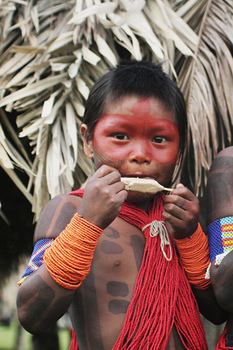Kayapo
The Kayapo (Caiapó in Portugese) are the native people of Brazil living on the plains of the Mato Grosso and Para, south of the Amazon Basin and along Rio Xingu and its tributaries. They have population of about 7,000. They call themselves Mebengokre or „the men from the water place“. There 4 subgroups of Kayapo people - Gorotire, Menkragnoti, Metyktire and Xikrin.
 Kayapo tribe chiefs - Raoniiii, Kaye, Kadjor, Panara
Kayapo tribe chiefs - Raoniiii, Kaye, Kadjor, Panara
Kayapo people live in the rainforests using a sustainable slash-and-burn horticulture. It is a type of farming where land is cultivated for a couple of years. Then people move to some other place and start everything all over again.
They live in villages made of dozen or so huts. One hut is located in the middle of their village. Only men can enter that house. There they talk about issues important for the community. The biggest Kayapo village is Gorotire. Its population is quite wealthy because they have concessions over gold mines located there. Smaller and not so wealthy village populated by the Kayapo people is Kapot.
The Kayapo people believe that their ancestors learned social skills from insects like bees. That is why mothers and children paint each other's bodies with patterns that are similar to animal or insect markings. They believe that when painted they can better communicate with the Spirit that exists everywhere - in the forest, in the river etc.
 Kayapo woman
Kayapo woman
Some of the Kayapo men still have disks (plates) in their lower lip. This can be mainly seen among older people. Younger Kayapo men do not have such disks anymore.
Women shave the special V shape into the scalp of their heads. Men have radiating feathers in their hair. Such feathers are symbols of the universe. Men also have a rope in their hair. The rope is a symbol of the cotton rope used by the first Kayapo who arrived from the sky.
 Kayapo woman and child
Kayapo woman and child
There is a legend about it. Long time ago, when Kayapo people were in the sky, two hunters were following a boar to its den. There they saw a hole in the ground. Through the hole they saw beautiful forest with many animals. They tied the rope on one side and put the rest of down towards Earth. Then, one after another all Kayapo people arrived to Earth.
 Kayapo man
Kayapo man
These ancestors lived far away in „the place where the sun rises“. There was no night like nowadays. They hunted, fished and slept during the daytime. For them there was no yesterday and tomorrow. Only today existed. They did not know fire. Kayapo people believe that a jaguar man learned them about the fire.
Elders play very important role in the everyday life. Almost every morning the elder („kupato“), with the “borduna” (a heavy wooden ornamental object, symbol of authority) in his hands, performs his duty. He walks around the village and talks loudly to the community about the tasks of the day, like fishing, hunting, the ritual dances etc. Everyone gathers and listens carefully. Later they all work together in carrying out the tasks.
Everything is shared. The family has its private property (home, field, tools), but everything is there for common good of the village. At the end of day nobody is left hungry. Fish caught, fruit gathered, for example, are shared.
For Kayapo people there is no difference between heavenly and earthly stuff. For them space, time, person or group are all sacred.
Uncles and aunts, godparents, grandparents play important roles in the education of children. Children play a lot. In games they often imitate the adults.
 Kayapo child
Kayapo child
The thing that Kayapo people hate most is talking bad about others. If the chiefs discover something like that, they organize a gathering to solve the problem.
Like in so many cases around the world, such indigenous communities have problems with big business. The plan for a huge hydroelectric dam on the Xingu River (a southern tributary of the Amazon) threatens Kayapo homes and environment as a whole. Let's hope for the positive solution.